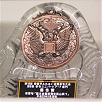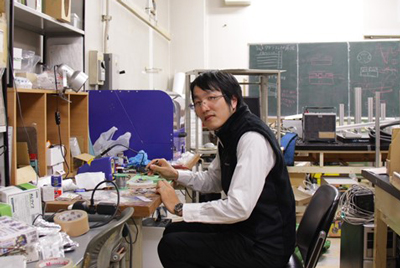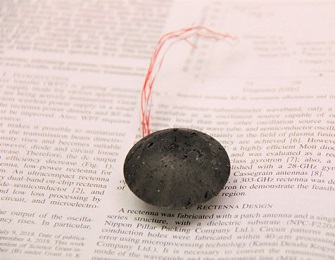TSUKUBA FUTURE
#107 Wireless Technology Changing the World
Assistant Professor SHIMAMURA Kohei, Faculty of Engineering, Information and Systems

The widespread adoption of transportation IC card systems has brought great convenience. But how do such cards work? In fact, inside these cards is a coil, which produces a current when the card is waved over a reader (reading device) that generates a magnetic field. This enables the card and the reader to communicate and exchange information. If a similar principle is used to convert radio waves into electricity, electronic products can also be used wirelessly. Prof. Shimamura is engaged in various researches centered on wireless electricity supply.

Electric vehicle development continues to advance, but the biggest obstacle is the weight of the vehicle batteries. In order to extend the driving range, large batteries must be installed, but doing so increases the vehicle weight, and the vehicle price also rises. On the other hand, driving with an extension cord dragging behind is not an option. Hence one solution that is attracting attention is wireless electricity supply. For example, coils which are electricity supply devices could be embedded in the roadway, to generate currents in vehicles that travel above them. Transportation IC cards and the wireless chargers of smartphones make use of this same magnetic field generation method, albeit on a smaller scale.
Another possible method is to emit radio waves and have the waves converted into electricity. This method suddenly came to the fore in 2007 when a research team at MIT developed a resonance type wireless power transmission apparatus for the first time. As a theoretical matter it had been vaguely expected, but until that time no-one had grappled with the engineering problem in earnest. In contrast with the magnetic field method, wireless power transmission over long distances is possible. Moreover, the higher the frequency of the radio waves emitted, the more the radio waves advance in a straight line, like a laser pointer, so that power can be transmitted with pinpoint accuracy. In the field of mobile communications, a transition from 4G to faster 5G systems is currently being studied. When this actually takes place, the speed of portable communications will be boosted 1000-fold or more over current systems, and frequency bandwidths exceeding 100 GHz will likely be newly secured.
This is still a matter for the near future, but in the research laboratory of Prof. Shimamura, in anticipation of future developments, the world's first reception circuit that can be used for wireless electricity supply in frequency bands above 100 GHz was developed. This device integrates an antenna and a rectifier circuit that converts AC radio waves into a direct current, and is called a "rectenna," combining parts of the names of each. In addition, a gyrotron developed at the Research Center for Development of Far-Infrared Region of the University of Fukui, capable of high-power microwave power transmission at frequencies above 100 GHz, was used to conduct wireless electricity supply experiments at a distance of 3 meters, and wireless electricity supply was successful at 303 GHz. Moreover, the DC output power per unit area of the rectenna circuit (rectenna power density) was the highest such value in the world to date. In past research on wireless electricity supply by radio waves, nearly all studies were conducted in the conventional communication microwave band (from several hundred MHz up to 5.8 GHz). This is due to problems with practical utilization; it is known that as the frequency is raised, the efficiency of a rectenna circuit declines, and it was thought that experiments exceeding 100 GHz would be difficult. Hence the results obtained by Prof. Shimamura swept away some preconceived notions. The gyrotron used in the experiments is a microwave (electromagnetic wave) generating device developed as part of nuclear fusion technology, and could be thought of as a giant microwave oven.
For the time being, Prof. Shimamura's goal is wireless electricity supply to a drone. Existing battery-based drones have limited flight times, but if wireless electricity supply became possible, they could continue to fly indefinitely. If this were achieved, flying taxis might no longer be just a dream. Moreover, airplanes and rockets might become capable of fuel-less flight. In the case of a rocket, for example, microwaves might be used for combustion in a plasma engine. All grand-sounding plans, but in fact technology is being studied in which a rectenna mounted on a rocket is tracked, and rocket launch experiments, though small in scale, are also being conducted. There is a fine processing apparatus for manufacturing rectenna circuits at the University of Tsukuba, and there is a small-size gyrotron in the Plasma Research Center. Further, the Tsukuba environment facilitates cooperation among researchers in related fields.
Prof. Shimamura was prompted to begin his research by his interest in the technology of airplane and rocket flight. From there, his field of activities expanded rapidly. His interests vary widely, and the shelves in his laboratory include books on alpine plants and ornithology. At one time he was into mountain climbing, and from that time his preoccupations broadened to include plants and wild birds, and haiku poems as well. There are 12 students in his laboratory, and their research themes are varied. Thinking it might be of use in providing guidance to his students, he made his way through a book on baseball coaching. Drawing on his perfectionist tendencies and wide range of interests, Prof. Shimamura is currently exploring further challenging areas of research.

The laboratory also serves as a workshop.

A model of a sample container for Hayabusa 2. Prof. Shimamura is also conducting joint research with JAXA.
A drone's flight experiment by wireless electricity supply
Article by Science Communicator at the Office of Public Relations


